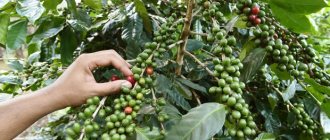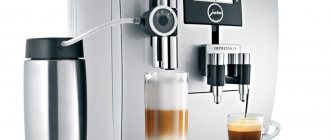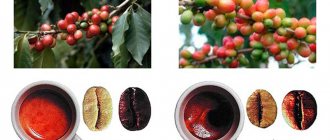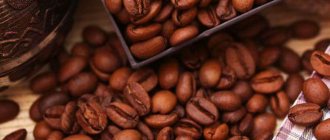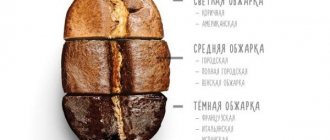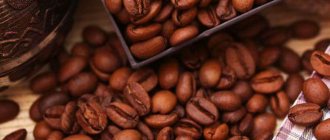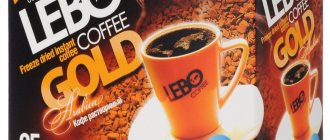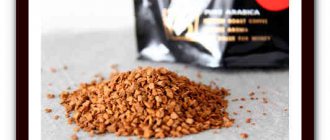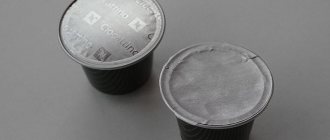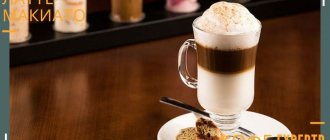What are Arabica and Robusta
Arabica and Robusta are evergreen coffee trees belonging to the coffee genus of the Rubiaceae family. The trees grow in equatorial climates, mainly in Africa, Asia, Central and South America. Arabica was born as a result of a natural crossing of two types of coffee: Eugenioides and Robusta. Yes, Robusta is the parent of Arabica. Details of their relationship, who appeared, how and where, can be found in our articles about Arabica and Robusta, and we will move on to the essence of the article.
Basic historical facts
- Place of discovery: The first mentions of Arabica were in Ethiopia, and Robusta in Uganda.
- Places of growth: Arabica is cultivated in America, Africa, Asia, the Caribbean and Oceania. Robusta is mainly cultivated on an industrial scale in Asia and Africa.
- Leader in production: Leader in Arabica production - Brazil, Robusta - Vietnam.
- Share in world production: 70% of the world volume belongs to Arabica, 30% to Robusta.
- Characteristics of the coffee tree
- Tree height: Arabica can grow up to 10 meters, robusta up to 15 meters.
- Growing altitude: Arabica grows from 900 to 2500 meters above sea level, robusta grows lower, from 200 to 900 meters.
- Resistance to parasites and diseases: Arabica is less resistant to diseases, robusta, on the contrary, has high resistance to parasites and diseases.
Bean price
It is difficult to give a definite answer regarding the price of both varieties. Most often, Arabica costs twice as much as Robusta. The cost depends on the effort spent on growing a particular variety, as well as on the taste of the resulting coffee. Arabica requires more careful care, but at the same time has a higher taste. Robusta usually costs less: it is unpretentious to grow, but its taste is much harsher. However, you should not determine the type of coffee based on its cost: sometimes sellers can price Robusta more expensive than Arabica, since the quality of the crop is much higher. Raw materials and their quality can significantly affect the final cost of coffee.
Varieties
The most popular varieties include the following:
- Bourbon Santos, one of the elite Brazilian varieties. For its production, grains are taken only from the first three years of harvest;
- Maragogyp, which is native to South America;
- Bali Shizan, with an unusual taste that combines cloves, persimmon and Jamaican pepper;
- Typica grows in Latin America and is one of the most expensive varieties. The fact is that it is grown only in the highlands and has a small yield;
- Catura, which is a Brazilian hybrid of very high quality;
- Venezuelan Caracas, attracting with its original smell;
- A plantation considered an Indian variety and characterized by a bitter chocolate taste and aroma that combines a whole bouquet of spices.
Each of these varieties has its own specific characteristics. But, at the same time, they all have a characteristic sweetish taste with a slight sourness.
Characteristics of coffee beans
- Bean shape: Arabica has a more elongated shape, Robusta is more round.
- Caffeine content: Arabica has half the caffeine content, 1-1.5%, than Robusta, 2-3%.
- Content of essential oils: Robusta contains half as much essential oils (8%) as Arabica (18%).
- Sugar content: Robusta contains two times less sugars (5%) than Arabica (8%).
Taste and aroma
These two varieties have completely different taste characteristics. Arabica is considered a softer drink that is practically not bitter. Robusta is much coarser than its counterpart, but in some varieties you can feel other notes of taste.
Sweetness
Sweet notes are, in principle, not characteristic of any type of coffee. Only some varieties may contain such notes: Indian Robusta (you can feel the nutty-chocolate flavor), Yemeni Arabica (chocolate flavor), etc.
Kislinka
The sourness is characteristic of the Arabica variety, since Robusta practically does not carry this shade, with the exception of the Indian version. Wine sourness can be felt in the Mayosor variety, and the berry aftertaste is characteristic of Guatemelian Arabica.
Bitterness
Arabica is practically not bitter - this property is more typical of robusta. This type of coffee is generally harsher in taste. There are small exceptions in this case: in Zambian Arabica you can feel a slight bitterness.
Size and appearance
The appearance of Robusta and Arabica is also very different from each other. However, if you know their main distinguishing features, then determining what exactly is in front of you will not be difficult.
- Arabica has oval-shaped grains, the size of which is about 7-8 mm. After the beans are roasted, they become uniformly brown in color.
- Robusta grains are more rounded and smaller in shape - their size is no more than 6 mm. After roasting, a large number of brown shades appear on the beans, so even after processing it is not difficult to distinguish between these two varieties.
Popular varieties
To put it correctly, Arabica is not a variety of coffee, but a type of coffee plant. Therefore, it is divided into a large number of varieties: Typica, Bali, Bourbon, Katura, Aramosa, Shinzan, etc. Each version of this coffee has its own specific features and aroma. Arabica is a classic type of coffee, which is why there are so many varieties based on it. Robusta does not boast as many varieties: these include Quilu, Ambry and Conillon du Brasil.
Kinds
The most common types of this coffee tree include:
- Ambry, common in Angola, where the conditions for its cultivation are most suitable;
- Conillon du Brasil, which originates in Brazil;
- Quilu, native to the Congo. This type is distinguished by high quality indicators; it is used to prepare expensive coffee mixtures.
You can learn the recipe for Viennese coffee, as well as the history of the drink, from our previous article.
Do you know how a cezve differs from a Turkish one? At first glance, it looks like nothing, but it’s not so. To broaden your horizons, you can read this material.
You can find out how and what to use to remove coffee stains from clothes, furniture or carpets here:
Areas and purposes of application
- In espresso coffee blends: Arabica is added for acidity, sweetness and aroma. Robusta for bitterness, density, strength and creams.
- In single-origin coffee: Arabica is suitable for those who like more acidic and aromatic coffee. Robusta is for those who like it stronger and appreciate bitterness in taste.
- In instant coffee: Mostly the cheapest, low quality coffee and Arabica and Robusta are used.
- In flavored coffee: Often the cheapest coffee is used, but sometimes more expensive items are flavored, both Arabica and Robusta.
Why is it considered that Robusta is worse than Arabica?
Among coffee lovers you can often hear the opinion that Robusta is much worse than Arabica, which means it is almost impossible to drink. In fact, the reasons for this stereotype are several factors:
- Robusta cannot offer such a variety of flavors and varieties, unlike Arabica;
- Huge difference in price: Arabica usually costs twice as much as Robusta;
- Conditions for growing varieties: usually they don’t spend a lot of time and effort on Robusta, so the quality of coffee can be much lower than that of Arabica.
Features of Robusta coffee
Another name for robusta is Congo tree. Its homeland is the African continent and the territory of Asia near the equator. The literal translation of robusta is “strong”. The name arose due to the unique vitality of the tree. It can grow in conditions unsuitable for other coffee trees.
At the end of the 19th century, a leaf rust epidemic raged across Sri Lanka. Because of it, all Arabica plantations were completely destroyed, farmers suffered colossal losses and were on the verge of ruin. Viable robusta turned out to be a salvation. These trees were massively planted in all plantations in Sri Lanka, and then in Madagascar and Brazil.
Coffee made from robusta beans was in demand in the domestic market. But at the first attempt to export, farmers failed. Consumers in Europe brewed coffee in a Turk, thereby increasing the bitterness and strength of Robusta. In addition, increased caffeine content inevitably led to increased heart rate and increased blood pressure. Commercial demand for Robusta has not met expectations.
The Robusta variety includes several subspecies, the most popular of which are ambri, conillon and bought.
Which is better Arabica or Robusta
Only one person can answer this question, you will find him in the mirror. After all, taste is a very subjective thing, everyone has their own. For one, green apples will be sour, but for another, on the contrary, just right. Therefore, you can only get to the bottom of your truth through trial and error. The only thing is, choose a good supplier, not store-bought coffee, but a company that roasts it itself, knows what’s inside its pack, will tell you about the coffee and help with the choice. It is important.
Summary table of differences between Arabica and Robusta
To summarize our comparison of the two varieties, let’s record all the distinctive features in a table.
| Arabica | Robusta | |
| Homeland of origin | Ethiopia | Congo River Basin |
| Share of coffee variety in the world market | 75% | 25% |
| Features of care and cultivation | It grows at altitudes of 800-2200 meters above sea level, requires special care, as it is vulnerable to diseases and negative environmental influences | It grows in valleys and at altitudes up to 600 meters above sea level. It does not require much effort to care for and has its own protection against diseases. |
| Pollination method | Cross | Self-pollination |
| Appearance of coffee | The grains are oval in shape, up to 8 mm in size. After frying, the brown color is distributed evenly | Round bean shape, uneven color after the roasting process, small size. |
| Taste | Several types of varieties with different tastes: mostly soft, with sourness | Hard taste with slight bitterness |
| Aroma | Strong and pleasant | Subtle |
| Fortress | Medium, low | High level |
| Price | It costs more than robusta because it requires more resources to grow. | Arabica is twice as cheap. |
What to choose: Arabica or Robusta
Selection of Arabica and Robusta. As we said earlier, delicious coffee is different for everyone, but we can only give a couple of recommendations for navigation when choosing your ideal cup:
All the recommendations given below are valid provided that the coffee is not heavily roasted, because if it is, then it doesn’t matter whether it’s Arabica or Robusta, everything will be the same: ashy and very bitter.
If you like more acidic coffee with a bright aroma, then try Arabica. Moreover, Arabica beans are also different; African beans will be more sour than, for example, those from Asia. As a rule, all roasters indicate the characteristics of each variety; look at them, this will help with your choice. Here, for example, is our assortment of Arabica beans.
- If you like your coffee stronger so that the bitterness dominates the taste, then try Robusta. Robusta is good coffee, it is popular, inexpensive, and those who “throw mud at it” are simply showing vanity. We roast only one variety of this coffee - Uganda Robusta.
- If you've read both of the previous points and think you need something in between, then take a look at espresso blends. Moreover, choose the one where the ratio of Arabica and Robusta seems optimal to you. We blend seven espresso blends with different percentages, which can satisfy the gastronomic needs of 99% of coffee lovers. At least that's what we think)
- If you read this article carefully, and not through a diagonal line, then you are more likely to know which coffee to choose.
But if you still have doubts, then write to us, we will help) See you soon.
Best Arabica coffee beans 2021
As you already understand, Robusta is for real coffee lovers. If you want something softer and more pleasant to taste, then this is definitely 100% Arabica.
And here are the highest quality products of this variety available in Russia:
- Cafecom Galapagos Gourmet. Rare Ecuadorian coffee with a slight sourness and rich taste with pronounced notes of citrus, mountain plants and spices. Suitable for almost any type of brewing.
- Lavazza Qualita Oro. The best collection of coffee with a very rich sweetish taste and intense malt-honey aroma. A slight sourness is felt. Medium roast and medium grind make this coffee versatile for any preparation method.
Lavazza is one of the best coffee producers in Italy and in the world
- Blue Mountain. An elite variety of Jamaican coffee in original packaging with an air release valve. The taste is very subtle, nutty and fruity, soft, without bitterness. Refers to strong brands.
- Lavazza Caffe Espresso. A combined product from Arabica beans from different regions, with a rich taste and aroma. The degree of roasting is light, the strength is also medium, 5 out of 10.
What could be better than an invigorating cup of espresso with foam in the morning?
- Jardin Cuin Dessp. Arabica beans roasted using Thermo Two technology. Created on the basis of a blend of two types of Arabica - from Africa and Central America. It has a rich dessert taste and aroma with a light, noble sourness. The advantage of this coffee is also its affordable price.
